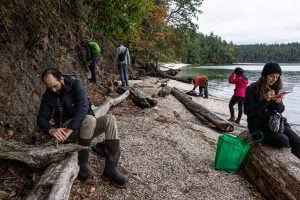
Environment
The sixth extinction
The planet is in the midst of drastic biodiversity loss that some experts think may be the next great species die-off. How did we get here and what can be done about it?
- 4895 words
- 20 minutes
Environment
Thanks in part to a donation from Kruger Products, the Nature Conservancy of Canada, in collaboration with Kebaowek First Nation, is protecting this ecologically significant island in the Ottawa River

Located in the Ottawa River between Ontario and Quebec is a small but ecologically significant island, home to species at risk like northern map turtle, butternut tree and giant pinedrop. It’s a special place where fish seem to spontaneously appear in ponds due to its location atop Canada’s longest underwater cave network. And thanks in part to a contribution from Kruger Products, and a collaboration between the Nature Conservancy of Canada (NCC) and Kebaowek First Nation, Fitzpatrick Island will be protected and conserved forever.
Fitzpatrick is one of three islands situated where the Ottawa River wraps around the Westneath Peninsula, about 145 kilometres northwest of the City of Ottawa. The area is home to more than 10 kilometres of subterranean tunnels, sinkholes and caves — the longest karst system in Canada.
“It’s very exceptional,” says Caroline Gagné, NCC program director for western Quebec. “Just for this system to exist is a rare occurrence.”
NCC has had its eye on the privately-owned island since 2012, when it began engaging in discussions with the Kebaowek First Nation on a plan to protect the property from future development. A private, non-profit organization, NCC secures natural areas through donation, purchase and conservation agreements. Once they are secured, NCC oversees the long-term management of the properties to ensure the conservation of their natural values. Since 1962, NCC has protected over 15 million hectares across the country.
A sizeable donation from Kruger Products helped finalize the purchase of Fitzpatrick Island this year. NCC is now working with the Kebaowek First Nation toward an official Anishinaabe Indigenous Protected and Conserved Area (IPCA) status for the island, the first of its kind on private land in the province. IPCAs are Indigenous-led conservation projects, with Indigenous laws, governance and knowledge systems at their core.
“We’re currently working to establish a joint conservation plan with the Algonquin Anishinabeg First Nation, our main goal being to ensure the island is protected for the long term,” says Gagné. “We’ll also be sharing knowledge and learning from one another along the way, which will help inform future projects of this kind.”

NCC is currently working on numerous other projects across Canada that are in specific collaboration with First Nations.
NCC prioritizes identifying and protecting sites with unique geological features that could support a variety of species at risk. In the case of Fitzpatrick Island, as water moves through the underlying cave system, the eroding rock contributes minerals to the soil that support several endangered plants. Two trees measuring more than 90 centimetres in diameter have also been found on the island, suggesting they could be hundreds of years old.
“It’s really a magical place,” says Gagné. “There’s always something new to discover.”
Currently there is no public access to the 34-hectare island. The only structure is a cottage, which Gagné says will be used by the Algonquin Anishinabeg Nation for ceremonial and educational purposes.
Learn more about the Nature Conservancy of Canada’s work at natureconservancy.ca.
Are you passionate about Canadian geography?
You can support Canadian Geographic in 3 ways:

Environment
The planet is in the midst of drastic biodiversity loss that some experts think may be the next great species die-off. How did we get here and what can be done about it?

Environment
As the impacts of global warming become increasingly evident, the connections to biodiversity loss are hard to ignore. Can this fall’s two key international climate conferences point us to a nature-positive future?

People & Culture
Naming leads to knowing, which leads to understanding. Residents of a small British Columbia island take to the forests and beaches to connect with their nonhuman neighbours

Environment
David Boyd, a Canadian environmental lawyer and UN Special Rapporteur on Human Rights and the Environment, reveals how recognizing the human right to a healthy environment can spur positive action for the planet